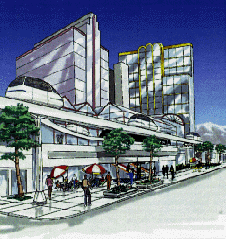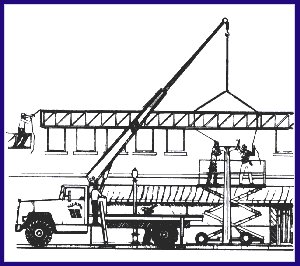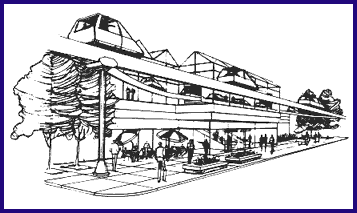 TAXI 2000 System
Concept (now called Skyweb Express)
TAXI 2000 System
Concept (now called Skyweb Express) TAXI 2000 System
Concept (now called Skyweb Express)
TAXI 2000 System
Concept (now called Skyweb Express)The TAXI 2000 system was developed by Dr. J. Edward Anderson and the TAXI 2000 Corporation over the span of time from 1981 to 1993. In 1993, the design rights were sold to the Raytheon Company. Raytheon continued to develop the concept, using their own design and called it PRT 2000. In 1999, Raytheon terminated its work on PRT 2000 and no longer has an active PRT project. The TAXI 2000 Corporation bought back its rights from Raytheon and has continued to develop its concept, now called Skyweb Express. Its system specifications are very similar to the 1993 concept which was transferred to Raytheon. As of late 2003, the Taxi 2000 Corporation has completed a Phase I prototype program and is soliciting funds for a Phase II development and testing program.
Vehicle and Guideway
The Skyweb Express prototype vehicle is composed of two primary components: a cab housing
the passenger seating area and a bogie responsible for guideway interface and vehicle
propulsion. Details about the prototype vehicle and guideway are available at the Skyweb
Express website.

Small elevated guideways can be simply erected along existing ROW.
Stations
Stations will utilize off-line siding to decelerate, debark/embark passengers and
accelerate vehicles. Station spacing will be approximately every 0.8 km (0.5 mile) or
closer in a dense PRT grid network, and farther apart in sparser networks. Station
locations will normally lie between intersections. For a network with vehicles travelling
at 48 km/h (30 mph), approximately 107 m (350 ft) of off-line guideway would be used.
Passengers will be able to order their vehicle and purchase tickets via ATM style machines
at the station. Most stations will contain 3 berths for vehicle loading/unloading,
although larger stations can be built if and when location demand warrants. Stations will
utilize elevated platforms level with the primary track and can be stand-alone or
integrated into existing urban structures. Since average passenger waiting times will be
on the order of a few minutes, station size is kept small, thereby reducing construction
cost, visual impact and problems due to crowd security. One or more stations in the
network will be specially designed as car barns to absorb excess vehicles during low
demand periods and provide locations for vehicle maintainance.

Off-line stations are used to significantly reduce trip times.
Performance
Service in a Skyweb Express system is "true PRT"; i.e. 24 hour on-demand,
non-stop and private (see What is PRT? for a concise
definition of "true PRT"). Line capacity should peak at 7200 vehicles per hour,
with 0.5 second vehicle headways and a line speed of 48 km/h. Line speeds will vary
between 32 to 80 km/h (20 to 50 mph) depending on track topography and geometry. Station
capacity can approach 2000 vehicles per hour for a large station. During off-peak hours,
station wait times will be neglible. Peak-hour station wait times will be such that 80% of
people will wait less than 30 seconds and 99% less than 2 minutes. Energy requirements for
the system will be 145 watt-hours per vehicle-mile at 40 km/h (25 mph). Vehicles will
operate nominally in winds up to 72 km/h (45 mph) and handle an elevation change of 15%
over 9.1 m (30 ft). Skyweb Express vehicle and guideway designs allow for normal operation
in rain, heavy snow, ice storms, freezing rain and moderate hail conditions. Design
considerations are taken into account for handicapped and elderly persons.